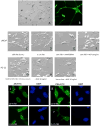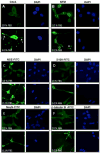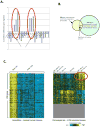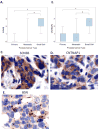Neuronal Trans-Differentiation in Prostate Cancer Cells
- PMID: 27403603
- PMCID: PMC5815867
- DOI: 10.1002/pros.23221
Neuronal Trans-Differentiation in Prostate Cancer Cells
Abstract
Background: Neuroendocrine (NE) differentiation in prostate cancer (PCa) is an aggressive phenotype associated with therapy resistance. The complete phenotype of these cells is poorly understood. Clinical classification is based predominantly on the expression of standard NE markers.
Methods: We analyzed the phenotype of NE carcinoma of the prostate utilizing in vitro methods, in silico, and immunohistochemical analyses of human disease.
Results: LNCaP cells, subjected to a variety of stressors (0.1% [v/v] fetal bovine serum, cyclic AMP) induced a reproducible phenotype consistent with neuronal trans-differentiation. Cells developed long cytoplasmic processes resembling neurons. As expected, serum deprived cells had decreased expression in androgen receptor and prostate specific antigen. A significant increase in neuronal markers also was observed. Gene array analysis demonstrated that LNCaP cells subjected to low serum or cAMP showed statistically significant manifestation of a human brain gene expression signature. In an in silico experiment using human data, we identified that only hormone resistant metastatic prostate cancer showed enrichment of the "brain profile." Gene ontology analysis demonstrated categories involved in neuronal differentiation. Three neuronal markers were validated in a large human tissue cohort.
Conclusion: This study proposes that the later stages of PCa evolution involves neuronal trans-differentiation, which would enable PCa cells to acquire independence from the neural axis, critical in primary tumors. Prostate 76:1312-1325, 2016. © 2016 Wiley Periodicals, Inc.
Keywords: nerves; neuroendocrine; neuronal trans-differentiation; neurons; prostate cancer; resistance phenotype; small cell.
© 2016 Wiley Periodicals, Inc.
Conflict of interest statement
Figures





Similar articles
-
Multipathways for transdifferentiation of human prostate cancer cells into neuroendocrine-like phenotype.Biochim Biophys Acta. 2001 May 28;1539(1-2):28-43. doi: 10.1016/s0167-4889(01)00087-8. Biochim Biophys Acta. 2001. PMID: 11389966
-
Neuroendocrine differentiation in prostate carcinoma: focusing on its pathophysiologic mechanisms and pathological features.G Chir. 2010 Nov-Dec;31(11-12):568-74. G Chir. 2010. PMID: 21232206
-
Neuroendocrine-like prostate cancer cells: neuroendocrine transdifferentiation of prostate adenocarcinoma cells.Endocr Relat Cancer. 2007 Sep;14(3):531-47. doi: 10.1677/ERC-07-0061. Endocr Relat Cancer. 2007. PMID: 17914087 Review.
-
Androgen deprivation induces human prostate epithelial neuroendocrine differentiation of androgen-sensitive LNCaP cells.Endocr Relat Cancer. 2006 Mar;13(1):151-67. doi: 10.1677/erc.1.01043. Endocr Relat Cancer. 2006. PMID: 16601285
-
Neural Transcription Factors in Disease Progression.Adv Exp Med Biol. 2019;1210:437-462. doi: 10.1007/978-3-030-32656-2_19. Adv Exp Med Biol. 2019. PMID: 31900920 Review.
Cited by
-
EMT, stemness and tumor plasticity in aggressive variant neuroendocrine prostate cancers.Biochim Biophys Acta Rev Cancer. 2018 Dec;1870(2):229-238. doi: 10.1016/j.bbcan.2018.06.006. Epub 2018 Jul 5. Biochim Biophys Acta Rev Cancer. 2018. PMID: 29981816 Free PMC article. Review.
-
A Testosterone Metabolite 19-Hydroxyandrostenedione Induces Neuroendocrine Trans-Differentiation of Prostate Cancer Cells via an Ectopic Olfactory Receptor.Front Oncol. 2018 May 28;8:162. doi: 10.3389/fonc.2018.00162. eCollection 2018. Front Oncol. 2018. PMID: 29892571 Free PMC article.
-
The Role of Neural Signaling in the Pancreatic Cancer Microenvironment.Cancers (Basel). 2022 Aug 31;14(17):4269. doi: 10.3390/cancers14174269. Cancers (Basel). 2022. PMID: 36077804 Free PMC article. Review.
-
Understanding and modeling nerve-cancer interactions.Dis Model Mech. 2023 Jan 1;16(1):dmm049729. doi: 10.1242/dmm.049729. Epub 2023 Jan 9. Dis Model Mech. 2023. PMID: 36621886 Free PMC article. Review.
-
Evolvability of cancer-associated genes under APOBEC3A/B selection.bioRxiv [Preprint]. 2023 Dec 5:2023.08.27.554991. doi: 10.1101/2023.08.27.554991. bioRxiv. 2023. Update in: iScience. 2024 Mar 06;27(4):109433. doi: 10.1016/j.isci.2024.109433. PMID: 38106028 Free PMC article. Updated. Preprint.
References
-
- Immediate versus deferred treatment for advanced prostatic cancer: initial results of the Medical Research Council Trial. The Medical Research Council Prostate Cancer Working Party Investigators Group. Br J Urol. 1997;79(2):235–46. Epub 1997/02/01. - PubMed
-
- Bolla M, Collette L, Blank L, Warde P, Dubois JB, Mirimanoff RO, Storme G, Bernier J, Kuten A, Sternberg C, Mattelaer J, Lopez Torecilla J, Pfeffer JR, Lino Cutajar C, Zurlo A, Pierart M. Long-term results with immediate androgen suppression and external irradiation in patients with locally advanced prostate cancer (an EORTC study): a phase III randomised trial. Lancet. 2002;360(9327):103–6. Epub 2002/07/20. - PubMed
-
- Bolla M, Gonzalez D, Warde P, Dubois JB, Mirimanoff RO, Storme G, Bernier J, Kuten A, Sternberg C, Gil T, Collette L, Pierart M. Improved survival in patients with locally advanced prostate cancer treated with radiotherapy and goserelin. N Engl J Med. 1997;337(5):295–300. doi: 10.1056/nejm199707313370502. Epub 1997/07/31. - DOI - PubMed
-
- D'Amico AV, Manola J, Loffredo M, Renshaw AA, DellaCroce A, Kantoff PW. 6-month androgen suppression plus radiation therapy vs radiation therapy alone for patients with clinically localized prostate cancer: a randomized controlled trial. JAMA. 2004;292(7):821–7. doi: 10.1001/jama.292.7.821. Epub 2004/08/19. - DOI - PubMed
Publication types
MeSH terms
Substances
Grants and funding
LinkOut - more resources
Full Text Sources
Other Literature Sources
Medical
Research Materials

